Exploring Magnets NCERT Solutions | Science for Class 6 PDF Download
Let us enhance our learning
Q1. Fill in the blanks
(i) Unlike poles of two magnets _______ each other, whereas like poles _______ each other.
Ans: Unlike poles of two magnets attract each other, whereas like poles repel each other.
(ii) The materials that are attracted towards a magnet are called _______.
Ans: The materials that are attracted towards a magnet are called magnetic materials.
(iii) The needle of a magnetic compass rests along the _______ direction.
Ans: The needle of a magnetic compass rests along the north-south direction.
(iv) A magnet always has _______ poles.
Ans: A magnet always has two poles.
Q2: State whether the following statements are True (T) or False (F).
(i) A magnet can be broken into pieces to obtain a single pole.
Ans: False
(ii) Similar poles of a magnet repel each other.
Ans: True
(iii) Iron filings mostly stick in the middle of a bar magnet when it is brought near them.
Ans: False
(iv) A freely suspended bar magnet always aligns with the north-south direction.
Ans: True
Q3: Column I shows different positions in which one pole of a magnet is placed near that of the other. Column II indicates the resulting interaction between them for different situations. Fill in the blanks.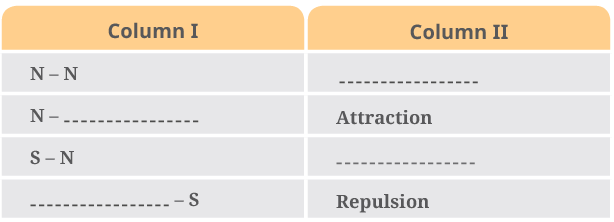
Ans: 
Q4: Atharv performed an experiment in which he took a bar magnet and rolled it over a heap of steel U-clips. According to you, which of the options given in Table 4.3 is likely to be his observation?
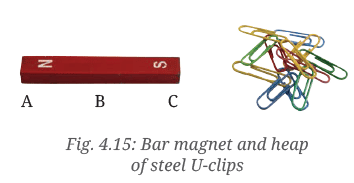
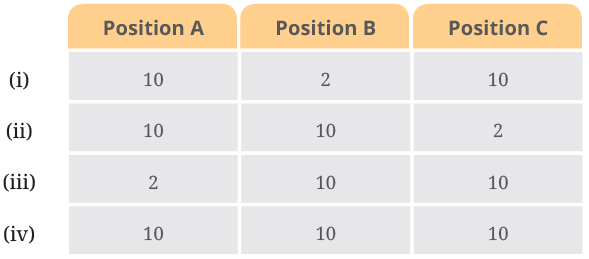 Table 4.3: Number of pins attracted by the magnet at its various positions
Table 4.3: Number of pins attracted by the magnet at its various positions
- Position A (North Pole): High attraction
- Position B (Middle): Low attraction
- Position C (South Pole): High attraction
Q5: Reshma bought three identical metal bars from the market. Out of these bars, two were magnets and one was just a piece of iron. How will she identify which two amongst the three could be magnets (without using any other material)?
Ans: Reshma can bring one metal bar close to the other two bars one by one. If it repels either of the two, then it is a magnet and the bar that it repels is also a magnet. The one which does not repel but only attracts is the piece of iron.
Q6: You are given a magnet that does not have the poles marked. How can you find its poles with the help of another magnet that has its poles marked?
Ans: To find the poles of an unmarked magnet, bring one end of the marked magnet near one end of the unmarked magnet. If they attract, the unmarked magnet's end is the opposite pole (i.e., if the marked North pole attracts, then the unmarked end is South pole). If they repel, then the poles are similar.
Q7: A bar magnet has no markings to indicate its poles. How would you find out near which end its North pole is located without using another magnet?
Ans: Suspend the magnet freely and let it align in the north-south direction. The end pointing towards the north direction is the North pole of the magnet.
Q8: If the earth is itself a magnet, can you guess the poles of the earth’s magnet by looking at the direction of the magnetic compass?
Ans: Yes, the end of the compass needle that points towards the North direction is the North-seeking pole, which means the geographic North pole of the Earth is the magnetic South pole, and the geographic South pole of the Earth is the magnetic North pole.
Q9: While a mechanics was repairing a gadget using a screwdriver, the steel screws kept falling. Suggest a way to solve the problem of the mechanic based on what you have learned in this chapter.
Ans: The mechanic can magnetize the screwdriver by stroking it several times with a magnet. This will make the screwdriver attract the steel screws, preventing them from falling.
Q10: Two ring magnets X and Y are arranged as shown in Fig. 4.16. It is observed that the magnet X does not move down further. What could be the possible reason? Suggest a way to bring the magnet X in contact with magnet Y, without pushing either of the magnets.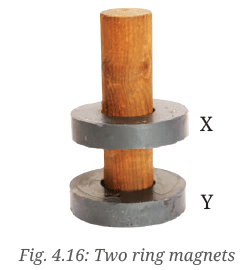
Ans: The possible reason is that like poles of the magnets X and Y are facing each other, causing repulsion. To bring magnet X in contact with magnet Y, flip magnet Y so that unlike poles face each other, resulting in attraction.
Q11: Three magnets are arranged on a table in the form of the shape shown in Fig. 4.17. What is the polarity, N or S, at the ends 1, 2, 3, 4, and 6 of the magnets? The polarity of one end (5) is given to you.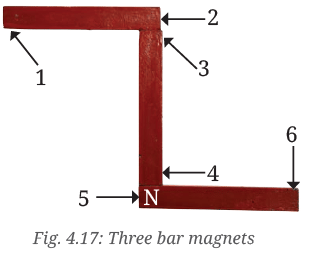 Ans: Based on the figure given here and knowing that magnetic poles always come in pairs (North and South), we can deduce the polarities at the ends:
Ans: Based on the figure given here and knowing that magnetic poles always come in pairs (North and South), we can deduce the polarities at the ends:
Given: End 5 is North (N). Knowing that the opposite end of a magnet is the opposite pole, the polarity at end 6, being the opposite end Of 5, will be South (S).
Now, considering how the magnets are arranged: The end 5 is North, and magnetically, the polarity flow is from North to South inside the magnet. So, the end connected to 5 (which is end 4) must be South.
Since magnet 3 is connected directly to end 4: End 3 (opposite to end 4) will be North (N).
The end connected to 3 (which is end 2) will be South (S),
Finally, the polarities can be stated as follows:
- End 1: North (N)
- End 2: South (S)
- End 3: North (N)
- End 4: South (S)
- End 6: South (S)
Mid-Chapter Questions
Q1. Do magnets stick to objects made of certain materials only? (Page 62)
Ans: Yes, the magnet attracts certain materials, whereas some do not get attracted towards the magnet. The materials which get attracted towards a magnet are magnetic, e.g. iron, nickel, cobalt, etc. The materials that are not attracted to a magnet are non-magnetic. In their natural states, metals such as aluminium, brass, copper, gold, lead and silver do not attract magnets.
Q2. Do all parts of a magnet attract magnetic materials equally? (Page 64)
Ans: No, all parts of a magnet do not have equal magnetic strength. In a bar magnet, the magnetic field around the poles is stronger than the middle part, where the magnetic field is weaker. Also in the case of a horseshoe magnet, the magnetic strength is higher near the poles.
Q3. Can we find a magnet with a single pole? (Page 65)
Ans: No, any magnet has always two poles, namely north and south. We cannot make a magnet with only one pole.
|
67 videos|280 docs|27 tests
|
FAQs on Exploring Magnets NCERT Solutions - Science for Class 6
| 1. What are the properties of magnets? |  |
| 2. How do magnets work? |  |
| 3. What is the difference between a permanent magnet and a temporary magnet? |  |
| 4. How can we make a magnet? |  |
| 5. How are magnets used in everyday life? |  |

















